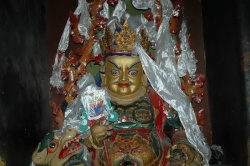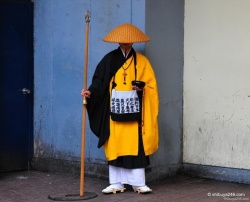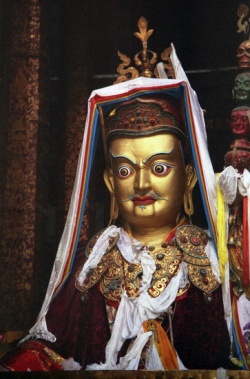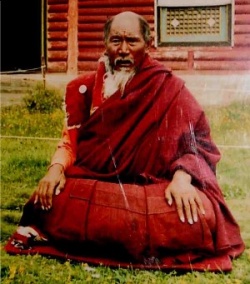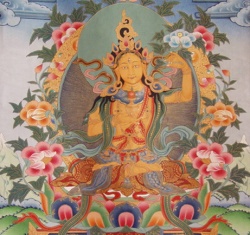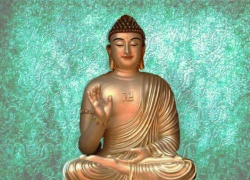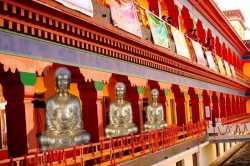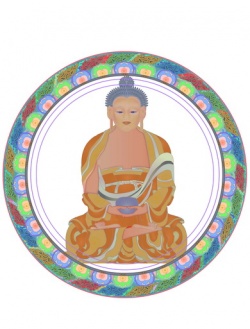Difference between revisions of "Nagarjuna's Sutrasamuccaya Nagarjuna’s Sutrasamuccaya"
(Created page with " <poem> FOREWORD It is, indeed, a {{Wiki|matter}} of no slight pleasure for me to provide a few preliminary remarks upon this meticulously prepared critica...") |
|||
| (2 intermediate revisions by the same user not shown) | |||
| Line 1: | Line 1: | ||
| − | + | <nomobile>{{DisplayImages|3105|1206|2985|2341|478|4286|2021|296|3413}}</nomobile> | |
| Line 6: | Line 6: | ||
FOREWORD | FOREWORD | ||
| − | It is, indeed, a {{Wiki|matter}} of no slight [[pleasure]] for me to provide a few preliminary remarks upon this meticulously prepared critical edition of the available [[Tibetan]] and {{Wiki|Chinese}} source-materials forming the textual basis of [[Bhikkhu]] Pasadika’s forthcoming study and translation of [[Nagarjuna’s]] celebrated {{Wiki|anthology}} of [[Mahayana scriptures]], entitled [[Sutrasamuccaya]]. | + | It is, indeed, a {{Wiki|matter}} of no slight [[pleasure]] for me to provide a few preliminary remarks upon this meticulously prepared critical edition of the available [[Tibetan]] and {{Wiki|Chinese}} source-materials forming the textual basis of [[Bhikkhu]] [[Pasadika’s]] forthcoming study and translation of [[Nagarjuna’s]] celebrated {{Wiki|anthology}} of [[Mahayana scriptures]], entitled [[Sutrasamuccaya]]. |
| − | The reader will not require to be reminded that the learned editor with his previous publications on Kasyapa-parivarta and [[Vimalakirtinirdesa]] already has many years of [[experience]] in the area of [[Mahãyãna]] [[Wikipedia:canonical|canonical]] texts. | + | The reader will not require to be reminded that the learned editor with his previous publications on [[Kasyapa-parivarta]] and [[Vimalakirtinirdesa]] already has many years of [[experience]] in the area of [[Mahãyãna]] [[Wikipedia:canonical|canonical]] texts. |
| − | What I have to say about the authenticity and importance of the Sũtrasamuccaya I have already expressed some years ago in my [[Nagarjuniana]] ([[Copenhagen]] 1982), pp. 172- 178. With regard to the arguments there advanced in | + | What I have to say about the authenticity and importance of the Sũtrasamuccaya I have already expressed some years ago in my [[Nagarjuniana]] ([[Copenhagen]] 1982), pp. 172- 178. With regard to the arguments there advanced in favor of the [[traditional]] attribution to [[Nagãrjuna]] the intervening years of my [[Madhyamika]] studies – often interrupted – have given me nothing of significance to add or change. I am, naturally, not dismayed at {{Wiki|learning}} that [[Bhikkhu]] [[Pasadika’s]] many years of study of this text has brought him to much the same conclusions about the authenticity of the Sũtrasamuccaya that I myself arrived at years ago. |
| − | Our text is important not only as a piece of eloquent {{Wiki|evidence}} of the [[religious]] background that Nãgarjuna shared with virtually all other [[Mahayana]] [[philosophers]] in [[India]], but also for the philological and historical value the abundance of quotations from [[Wikipedia:canonical|canonical]] texts provide students of early [[Mahãyãna]] with. For this [[reason]] the Sũtrasamuccaya can be employed as one among other starting points for receding into the obscure and tantalizing days of the formation of [[Mahayana]] in [[India]]. | + | Our text is important not only as a piece of eloquent {{Wiki|evidence}} of the [[religious]] background that [[Nãgarjuna]] shared with virtually all other [[Mahayana]] [[philosophers]] in [[India]], but also for the philological and historical value the abundance of quotations from [[Wikipedia:canonical|canonical]] texts provide students of early [[Mahãyãna]] with. For this [[reason]] the Sũtrasamuccaya can be employed as one among other starting points for receding into the obscure and tantalizing days of the formation of [[Mahayana]] in [[India]]. |
One of the most urgent current requirements in [[Mahayana]] studies is to have reliable critical editions and translations (not just translations!) of some of the early [[sutras]] the importance of which can be inferred from their [[manifest]] influence upon later [[sastras]], through citations, {{Wiki|terminology}}, etc. | One of the most urgent current requirements in [[Mahayana]] studies is to have reliable critical editions and translations (not just translations!) of some of the early [[sutras]] the importance of which can be inferred from their [[manifest]] influence upon later [[sastras]], through citations, {{Wiki|terminology}}, etc. | ||
| − | The efforts of [[Mahayana]] [[scholars]] in recent years have provided us with a good foundation on which to continue {{Wiki|future}} work: We have Weller’s works on the Kasyapaparivarta, Conze’s on the various Prajnaparamitasũtras, Braarvig’s on the Aksãyamatinirdesasutra, | + | The efforts of [[Mahayana]] [[scholars]] in recent years have provided us with a good foundation on which to continue {{Wiki|future}} work: We have Weller’s works on the [[Kasyapaparivarta]], [[Conze’s]] on the various [[Prajnaparamitasũtras]], [[Braarvig’s]] on the [[Aksãyamatinirdesasutra]], [[Lamotte]]’s on the [[Vimalakir-tinirdesasũtra]], etc., {{Wiki|Python}} on the [[Upăliparíprcchă]], [[Ensink]] on the [[Rastrapalapariprccha]] Harrison’s on the [[Pratyutpannabuddhasammukhavasthitasamadhisũtra]], Nobel’s on the [[Suvarnaprabhasottamasutra]], etc. |
| − | Among these fine contributions and many other valuable works (a convenient {{Wiki|bibliographical}} guide to which is given by Peter Pfandt, [[Mahayana Texts]] translated into [[Western]] [[Languages]], Koln 1986) [[Bhikkhu]] Pasadika’s stands out as one of the most notable. | + | Among these fine contributions and many other valuable works (a convenient {{Wiki|bibliographical}} guide to which is given by Peter Pfandt, [[Mahayana Texts]] translated into [[Western]] [[Languages]], Koln 1986) [[Bhikkhu]] [[Pasadika’s]] stands out as one of the most notable. |
[[Copenhagen]], November 1989 | [[Copenhagen]], November 1989 | ||
| Line 24: | Line 24: | ||
ACKNOWLEDGEMENTS | ACKNOWLEDGEMENTS | ||
| − | With deep [[appreciation]] and thankfulness I should like to thank all those who helped me in connection with the {{Wiki|present}} work. The greatest debt of [[gratitude]] I owe to my [[Indian]] Kalyãnamitra, the late Prof. Dr. L.M. Joshi (1935-1984) who, In the early 70-ies, impressed on me the importance of the [[Sutrasamuccaya]] and the necessity of critically editing and translating the available source-materials. It was also through the good offices of Prof. Joshi that I received from [[Toyo Bunko]] in [[Tokyo]] and from the [[Oriental Institute]] of the {{Wiki|Academy}} of {{Wiki|Sciences}} in [[Prague]] xeroxes of the [[Derge edition]] of the [[Sutrasamuccaya]]. Again, through the kind help of Prof. Joshi and the Ven. AcArya [[Lozang]] | + | With deep [[appreciation]] and thankfulness I should like to thank all those who helped me in connection with the {{Wiki|present}} work. The greatest debt of [[gratitude]] I owe to my [[Indian]] [[Kalyãnamitra]], the late Prof. Dr. L.M. Joshi (1935-1984) who, |
| + | |||
| + | In the early 70-ies, impressed on me the importance of the [[Sutrasamuccaya]] and the necessity of critically editing and translating the available source-materials. | ||
| + | |||
| + | It was also through the good offices of Prof. Joshi that I received from [[Toyo Bunko]] in [[Tokyo]] and from the [[Oriental Institute]] of the {{Wiki|Academy}} of {{Wiki|Sciences}} in [[Prague]] xeroxes of the [[Derge edition]] of the [[Sutrasamuccaya]]. | ||
| + | |||
| + | Again, through the kind help of Prof. Joshi and the Ven. [[AcArya]] [[Lozang Jaraspall]] received xeroxes of the [[Narthang edition]] of the same text from {{Wiki|Columbia University}}. | ||
| + | |||
| + | As for the ‘[[red]] {{Wiki|Peking}}’ [[xylographic]] print of the Sũtrasamuccaya, I am grateful to the Bibllotheque Nationale In {{Wiki|Paris}} for providing me with a photostat copy, and for the [[Chone]] microfiche edition of the same work and the [[Tibetan]] text of the [[Siksasamuccaya]] I am much beholden to The [[Institute for Advanced Studies of World Religions]] in {{Wiki|New York}}. | ||
| − | + | Xeroxes of the {{Wiki|Chinese}} and [[Japanese]] translations, respectively, I could obtain thanks to the [[kindness]] of the directors and [[staff]] members of Seminar fur Indologle und Buddhlsmuskunde, {{Wiki|University}} of Gottingen, and Institut de recherche bouddhique Linh-Son, Jolnville-le-Pont ({{Wiki|Paris}}). | |
| − | To the following [[scholars]] I am particularly obliged for [[precious]] pieces of advice and [[information]] as far as things Indo-Tibetan and {{Wiki|Chinese}} as well as [[Wikipedia:scientific method|methodology]] are concerned – to: Ven. Dr. Thich Huyen-Vi, Ven. [[Acarya]] L. Jamspal, Prof. Dr. Chr. [[Lindtner]], Prof. Dr. D. [[Seyfort Ruegg]], [[Peter Skilling]] and, last not least, Ven. [[Geshe]] Lobsang Tengya. | + | To the following [[scholars]] I am particularly obliged for [[precious]] pieces of advice and [[information]] as far as things Indo-Tibetan and {{Wiki|Chinese}} as well as [[Wikipedia:scientific method|methodology]] are concerned – to: Ven. Dr. Thich Huyen-Vi, Ven. [[Acarya]] L. Jamspal, Prof. Dr. Chr. [[Lindtner]], Prof. Dr. D. [[Seyfort Ruegg]], [[Peter Skilling]] and, last not least, Ven. [[Geshe]] [[Lobsang Tengya]]. |
Finally I offer special thanks to Prof. [[Lindtner]] for kindly [[writing]] a foreword to this edition and for his [[constant]] [[Interest]] in my work on the {{Wiki|present}} text; likewise to Dr. Per K. [[Sorensen]] for accepting the [[mDo]] [[kun las btus pa]] for publication In the “Fontes Tibetici Havnienses Series” [[initiated]] by him. | Finally I offer special thanks to Prof. [[Lindtner]] for kindly [[writing]] a foreword to this edition and for his [[constant]] [[Interest]] in my work on the {{Wiki|present}} text; likewise to Dr. Per K. [[Sorensen]] for accepting the [[mDo]] [[kun las btus pa]] for publication In the “Fontes Tibetici Havnienses Series” [[initiated]] by him. | ||
Latest revision as of 08:55, 9 November 2015
FOREWORD
It is, indeed, a matter of no slight pleasure for me to provide a few preliminary remarks upon this meticulously prepared critical edition of the available Tibetan and Chinese source-materials forming the textual basis of Bhikkhu Pasadika’s forthcoming study and translation of Nagarjuna’s celebrated anthology of Mahayana scriptures, entitled Sutrasamuccaya.
The reader will not require to be reminded that the learned editor with his previous publications on Kasyapa-parivarta and Vimalakirtinirdesa already has many years of experience in the area of Mahãyãna canonical texts.
What I have to say about the authenticity and importance of the Sũtrasamuccaya I have already expressed some years ago in my Nagarjuniana (Copenhagen 1982), pp. 172- 178. With regard to the arguments there advanced in favor of the traditional attribution to Nagãrjuna the intervening years of my Madhyamika studies – often interrupted – have given me nothing of significance to add or change. I am, naturally, not dismayed at learning that Bhikkhu Pasadika’s many years of study of this text has brought him to much the same conclusions about the authenticity of the Sũtrasamuccaya that I myself arrived at years ago.
Our text is important not only as a piece of eloquent evidence of the religious background that Nãgarjuna shared with virtually all other Mahayana philosophers in India, but also for the philological and historical value the abundance of quotations from canonical texts provide students of early Mahãyãna with. For this reason the Sũtrasamuccaya can be employed as one among other starting points for receding into the obscure and tantalizing days of the formation of Mahayana in India.
One of the most urgent current requirements in Mahayana studies is to have reliable critical editions and translations (not just translations!) of some of the early sutras the importance of which can be inferred from their manifest influence upon later sastras, through citations, terminology, etc.
The efforts of Mahayana scholars in recent years have provided us with a good foundation on which to continue future work: We have Weller’s works on the Kasyapaparivarta, Conze’s on the various Prajnaparamitasũtras, Braarvig’s on the Aksãyamatinirdesasutra, Lamotte’s on the Vimalakir-tinirdesasũtra, etc., Python on the Upăliparíprcchă, Ensink on the Rastrapalapariprccha Harrison’s on the Pratyutpannabuddhasammukhavasthitasamadhisũtra, Nobel’s on the Suvarnaprabhasottamasutra, etc.
Among these fine contributions and many other valuable works (a convenient bibliographical guide to which is given by Peter Pfandt, Mahayana Texts translated into Western Languages, Koln 1986) Bhikkhu Pasadika’s stands out as one of the most notable.
Copenhagen, November 1989
ACKNOWLEDGEMENTS
With deep appreciation and thankfulness I should like to thank all those who helped me in connection with the present work. The greatest debt of gratitude I owe to my Indian Kalyãnamitra, the late Prof. Dr. L.M. Joshi (1935-1984) who,
In the early 70-ies, impressed on me the importance of the Sutrasamuccaya and the necessity of critically editing and translating the available source-materials.
It was also through the good offices of Prof. Joshi that I received from Toyo Bunko in Tokyo and from the Oriental Institute of the Academy of Sciences in Prague xeroxes of the Derge edition of the Sutrasamuccaya.
Again, through the kind help of Prof. Joshi and the Ven. AcArya Lozang Jaraspall received xeroxes of the Narthang edition of the same text from Columbia University.
As for the ‘red Peking’ xylographic print of the Sũtrasamuccaya, I am grateful to the Bibllotheque Nationale In Paris for providing me with a photostat copy, and for the Chone microfiche edition of the same work and the Tibetan text of the Siksasamuccaya I am much beholden to The Institute for Advanced Studies of World Religions in New York.
Xeroxes of the Chinese and Japanese translations, respectively, I could obtain thanks to the kindness of the directors and staff members of Seminar fur Indologle und Buddhlsmuskunde, University of Gottingen, and Institut de recherche bouddhique Linh-Son, Jolnville-le-Pont (Paris).
To the following scholars I am particularly obliged for precious pieces of advice and information as far as things Indo-Tibetan and Chinese as well as methodology are concerned – to: Ven. Dr. Thich Huyen-Vi, Ven. Acarya L. Jamspal, Prof. Dr. Chr. Lindtner, Prof. Dr. D. Seyfort Ruegg, Peter Skilling and, last not least, Ven. Geshe Lobsang Tengya.
Finally I offer special thanks to Prof. Lindtner for kindly writing a foreword to this edition and for his constant Interest in my work on the present text; likewise to Dr. Per K. Sorensen for accepting the mDo kun las btus pa for publication In the “Fontes Tibetici Havnienses Series” initiated by him.
Bh. Pa.
TABLE OP CONTENTS
Abbreviations
Introduction
Tibetan text of SS
Part I (bam po dan po)
First Theme: sans rgyas ’byun ba sin tu rned par dka’ba
Second Theme: mir ‘gyur ba ft in tu rned par dka’ba
Third Theme: dal ba ‘byor pa rfled par dka’ ba
Fourth Theme: de bzin gftegs pa’i bstan pa la dad pa rfled par dka’ ba
Fifth Theme: byan chub tu sems bskyed pa’i sems can de dag rfled par dka’ ba
Sixth Theme: sems can mams la afli rje che ba ni rned par dka’ ba
Seventh Theme: bar du gcod pa’i chos rnams yons su spon ba’i sems can de dag ni ches rned par dka’ ba
Part II (bam po gflis pa)
(h, i) Eighth Theme: gan dag khyim par gyur kyan chos rnams la nan tan gyis sgrub pa’i sems can rnams ni chea rfted par dka’ ba
(h, ii) Eighth Theme: khyim pa rnams kyi log par bsgrub pa
(h, iii) Eighth Theme: lonsa spyod daA arog la chaga pa yan khyim pa rnams kyi log par bagrub pa
Part III (bam po gsum pa)
(h, iv) Eighth Theme: nan tan bsgrub par ‘dod pas dge ba’i bftea gflen dag la brten par bya ba
Ninth Theme: gan dag de bfcin goegs pa mama kyi yons su mya nan las ‘das pa la yan dag pa ji lta ba bfcin du mos pa’i sems can de dag ni &in tu nted par dka ba
Part IV (bam po bzi pa)
Tenth Theme: theg pa gcig la mos pa’i seras can de dag ni sin tu rned par dka’ ba
Part V (bam po lna pa)
Eleventh Theme: gan sans rgyas dan byan chub sems dpa’i che ba nid rgya chen po la ‘jug pa’i sems can de dag nỉ ã in tu rned par dka’ ba
Colophon
Appendix
Dà chéng bào yão yì lùn, Chinese transl. of SS
Concordance
Bibliography
Source
http://thuvienphatgiaoonline.com/book/nagarjuna-s-sutrasamuccaya/
